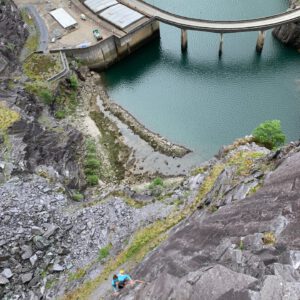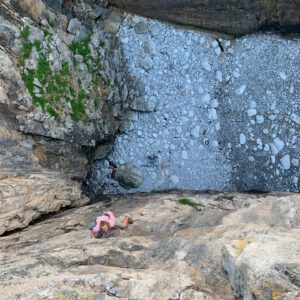Wales is a world-class and historic trad destination, with sea cliffs, mountain crags, and every type of climbing: from easily accessible, well-protected classics to wild and remote adventures. Christelle Bakhache and I spent a week climbing in North Wales, then cycled to Pembroke over three days, and spent another week there.
How to get there
We travelled by train from our house near Chamonix (France) to London, using local trains, TGV, and finally the Eurostar to take us to St. Pancras, in the middle of London. We stayed overnight with some friends, but you can also continue your journey if you’re organised with the onward travel.
Then we took small trains from London to Bangor (Gwynedd) and cycled to Llanberis - one of the best places to be based for climbing in North Wales.
We had to do a lot of faff to take our bikes on the TGV (put bikes in soft bike bags) and on the Eurostar (put the bike through the scanner! before putting it in a bike bag again).
The trains in the UK were either easy to travel with bikes, or (mostly) very annoying. They don’t have many special bike places so you must try to be the first person to put the bike onboard. On major trains, like going from Manchester to Bangor, we had to get a free bike ticket, but you must get this at least 30 minutes before your train. We missed one train because of this. The trains in the UK are also slow and usually late or delayed, so leave extra time with your travel!
From Bangor to Llanberis is a ~1hr 30 minute cycle ride along roads.
We then cycled 300km from Llanberis to Pembroke over three days. This was very hilly and we did about 1000m of ascent and descent every day. Sometimes it was on quiet roads and was very peaceful… other times it was on a major road with a lot of traffic. You often pass through small villages and towns where you can stop for supplies and accommodation. We did one day from Llanberis to Llanbedr, one day from Llanbedr to Aberaeron, then Aberaeron to Pembroke (specifically, Bosherston Campsite). Some friends recommended we take this route (Take the Sustrans Route 8 also known as Lon Las Cymru. It’ll get you from North wales (Caernarfon/Porthmadog) to Machynlleth and then you’ll probably want to hug the coast to Pembroke. There’s also usually a steady stream of folk making the trip from Llanberis to Pembroke and back again so def work asking around for a ride in a van weather/legs/time depending) but we mostly just followed the major road down using google maps, which was ok apart from some sections with heavy traffic.
Where to stay
Llanberis has a lot of accommodation, from cheap campsites (YHA Snowdon Llanberis, but annoyingly it’s up a hill!), hostels, rooms to rent, and AirBnBs. There is a small supermarket (Spar), lots of good cafes (Rum Doodle), and some climbing gear shops (V12 Outdoor and Joe Brown). You can also buy guide books from them. I’d recommend the guidebook North Wales Rock by Ground Up.
Pembroke is simple: you have a basic campsite in Bosherston (a field with some small toilets and a fresh water tap). You can just arrive any time, and the farmer will meet you in the morning. There are rooms to rent - like you can stay at the pub (2 minutes walk away from the campsite, called St Govan’s Inn). However, there are some extra logistics with Pembroke - you need to check when the area is closed because of military practice here. And you need to know the tide times (check here) because many climbs have to be accessed at low tide. There are always things to climb no matter the tides, however, but it’s just easier when the sea is out!
How to reach the crag(s)
Llanberis is a great place to be based because a lot of good climbing is nearby, like the slate quarries and the Llanberis Pass, where you have famous crags like Dinas Cromlech, Dinas Mot, and Scimitar Ridge. You can walk from Llanberis to the slate quarries, and you can cycle south on the main road (A4086) for 40 minutes until you reach the heart of the Llanberis Pass.
There’s a lot of great trad climbing in the Llanberis Pass, and a lot of trad + sport climbing in the slate quarries, but you can also travel to the coast to get better weather and different types of climbing - like the world-famous Gogarth near Holyhead on Anglesey for adventurous sea-cliff climbing, or the Orme near Llandudno for limestone sport, trad and bouldering. Both of these destinations would be too far away to visit in one day with a bike, so either meet local climbers who can help by giving you a lift in their car, or take the train and your bike and stay for a few days.
For Pembroke: You can cycle to dozens of really good crags, but there are no supermarkets etc nearby - you have to cycle to Pembroke town to get everything you need. To cycle to the crags, follow the road signs to St Govan’s. From the St Govan’s car park, you can use a guidebook to find the crags.
Tips
A UK trad climbing rack is:
- two-and-a-half sets of wires (nuts/stoppers)
- Nut ket
- 15 long quickdraws
- 6 extender (60cm) quickdraws
- 1 set of cams
- 1 set of micro wires
- 1 set of micro cams
- 5 slings (120cm)
- 2x 50metre double ropes
For Pembroke you need a (static) abseil rope, at least 50metre. The weather can be changeable. If it’s mixed in north Wales in the mountains, go to the coast (Gogarth, the Orme, or the Llyn Peninsuala) for better weather.
This is an amazing, easily accessible crag in North Wales. And this is an amazing, easily accessible crag in Pembroke.
UKClimbing.com is a great UK resource for information on the routes, crags, approaches.
How to book the trip
You should book some of your train travel in advance: the TGV through sncf and the Eurostar through their website. For the small UK trains you can buy a ticket at the station. Ideally arrive 30 minutes before the train to buy the tickets and check they are happy with your bikes.







